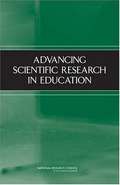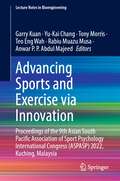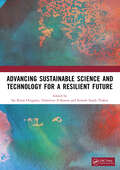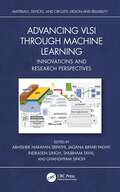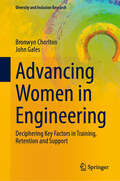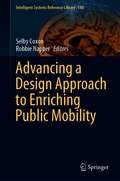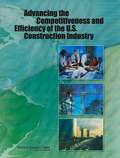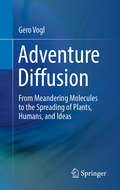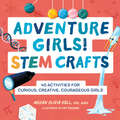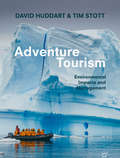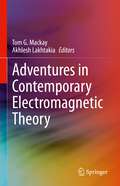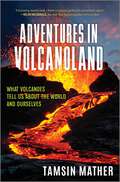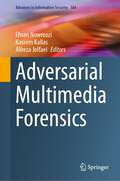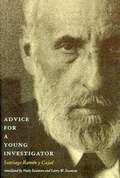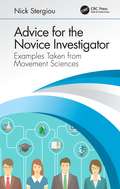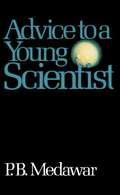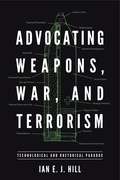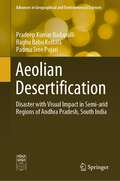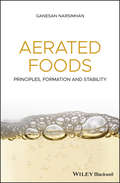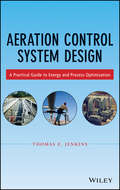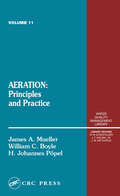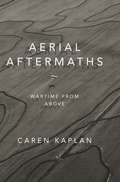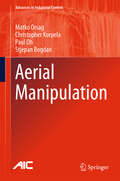- Table View
- List View
Advancing Scientific Research In Education
by National Research Council of the National AcademiesTransforming education into an evidence-based field depends in no small part on a strong base of scientific knowledge to inform educational policy and practice. Advancing Scientific Research in Education makes select recommendations for strengthening scientific education research and targets federal agencies, professional associations, and universities—particularly schools of education—to take the lead in advancing the field.
Advancing Sports and Exercise via Innovation: Proceedings of the 9th Asian South Pacific Association of Sport Psychology International Congress (ASPASP) 2022, Kuching, Malaysia (Lecture Notes in Bioengineering)
by Tony Morris Rabiu Muazu Musa Anwar P. P. Abdul Majeed Garry Kuan Yu-Kai Chang Teo Eng WahThis book presents the proceedings of the 9th Asian South Pacific Association of Sport Psychology International Congress (ASPASP) 2022, Kuching, Malaysia, which entails the different sporting innovation themes, namely, Applied Sport and Social Psychology, Health and Exercise, Motor Control and Learning, Counselling and Clinical Psychology, Biomechanics, Data Mining and Machine Learning in Sports amongst others. It presents the state-of-the-art technological advancements towards the aforesaid themes and provides a platform to shape the future direction of sport science, specifically in the field sports and exercise psychology.
Advancing Strategic Science: A Spatial Data Infrastructure Roadmap for the U.S. Geological Survey
by Committee on Spatial Data Enabling USG Strategic Science in the 21st CenturyScience is increasingly driven by data, and spatial data underpin the science directions laid out in the 2007 U. S. Geological Survey (USGS) Science Strategy. A robust framework of spatial data, metadata, tools, and a user community that is interactively connected to use spatial data in an efficient and flexible way--known as a spatial data infrastructure (SDI)--must be available for scientists and managers to find, use, and share spatial data both within and beyond the USGS. Over the last decade, the USGS has conducted breakthrough research that has overcome some of the challenges associated with implementing a large SDI. Advancing Strategic Science: A Spatial Data Infrastructure Roadmap for the U. S. Geological Survey is intended to ground those efforts by providing a practical roadmap to full implementation of an SDI to enable the USGS to conduct strategic science.
Advancing Sustainable Science and Technology for a Resilient Future
by Dimitrios A Karras Sai Kiran Oruganti Srinesh Singh ThakurThe Industrial Internet of Things (IIoT) has become an effective tool with significant implications for industrialisation and Market Research (MR), especially in the field of green production. Green IIoT (GRIIoT) can be used to implement Green Production (GP) goals for the environment. The purpose of this study is to examine the drivers behind the adoption of GIIoT, MR, and industrialization decision-making, as well as the effects these drivers have on industrialization performance (IP). A structured questionnaire was used to gather information in order to evaluate the suggested study paradigm. The results indicate that institutional isomorphism influences the acceptance of GRIIoT in a favorable way. Furthermore, Green innovation (GI) activities that result in IP are favorably correlated with GIIoT. The potential effects of the various institutional isomorphisms discussed in this study can aid organizations in better understanding the responsibilities to protect and satisfying stakeholders, particularly as the adopt GIIoT to handle production problems and possible accordance pressures in the process.
Advancing VLSI through Machine Learning: Innovations and Research Perspectives (Materials, Devices, and Circuits)
by Ghanshyam Singh Shubham Tayal Indrasen Singh Abhishek Narayan Tripathi Jagana Bihari PadhyThis book explores the synergy between very large-scale integration (VLSI) and machine learning (ML) and its applications across various domains. It investigates how ML techniques can enhance the design and testing of VLSI circuits, improve power efficiency, optimize layouts, and enable novel architectures.This book bridges the gap between VLSI and ML, showcasing the potential of this integration in creating innovative electronic systems, advancing computing capabilities, and paving the way for a new era of intelligent devices and technologies. Additionally, it covers how VLSI technologies can accelerate ML algorithms, enabling more efficient and powerful data processing and inference engines. It explores both hardware and software aspects, covering topics like hardware accelerators, custom hardware for specific ML tasks, and ML-driven optimization techniques for chip design and testing.This book will be helpful for academicians, researchers, postgraduate students, and those working in ML-driven VLSI.
Advancing Women in Engineering: Deciphering Key Factors in Training, Retention and Support (Diversity and Inclusion Research)
by John Gales Bronwyn ChorltonThe percentage of women applying for engineering licensure remains well below the percentage of women enrolling in engineering undergraduate programs--an issue of retention that continues throughout women engineers' career trajectories. Although there have been many efforts on the recruitment side to attract people of varying genders to study engineering and join the profession, such efforts are ineffective if this diverse population is not retained in engineering. This book identifies the factors affecting the recruitment of women into, and the retention of women in the engineering profession. The authors examine the experience of male and female students at the high school, undergraduate, and graduate levels to better understand women's experiences at each stage in their careers through to becoming industry members or academics. Issues such as intimidation and discouragement at the undergraduate level, disproportionate funding and support at a graduate student level, and the correlation between retention and opportunities for collaboration at an industry/academic level are discussed. The book concludes by highlighting the key findings affecting the retention of women in engineering and offers potential solutions. The findings covered in this book may be used by engineering postsecondary institutions and workplaces to create a more diverse and inclusive environment. This book is also useful to researchers, scholars, students, and academics interested in the retention of women in STEM industries.
Advancing a Circular Economy: A Future without Waste?
by Stephen M JonesThis book explores an escalating modern-day crisis; managing waste in a sustainable way. The central question posed is whether advancing a circular economy provides a way to shift waste management practices towards more sustainable approaches. It begins with an in-depth analysis of the nature of waste management and the prevailing crisis, followed by a discussion about the circular economy in terms of its requirements and the challenges of implementation. The book then moves on to propose a framework that sets out how to establish the policy changes needed to advance a circular approach to waste management. Next, the book outlines complex issues in multilevel systems for advancing a circular economy through examining the contemporary situation in Belgium and Norway. It ends by bringing together the issues revealed in these case studies and draws insights for governments advocating circular approaches. The book will be a valuable resource to scholars, students, practitioners and policy makers interested in developing more sustainable methods of waste management.
Advancing a Design Approach to Enriching Public Mobility (Intelligent Systems Reference Library #198)
by Selby Coxon Robbie NapperThis book examines research at the intersection of design and public mobility from both an academic and practice perspective. An eclectic collection of projects and topics not normally found in the mainstream literature on transportation, from implementing gender-sensitive design to examining how to reconceptualize future public interactions with mobility. The book brings together leading thinkers in design and mobility from around the world and from different modal perspectives sharing insights into how we navigate the emerging public mobility landscape. This collection is valuable for transport operators and practitioners seeking to better understand the impact design can have on public mobility and innovate in a rapidly changing operational environment.
Advancing the Competitiveness and Efficiency of the U.S. Construction Industry
by National Research Council of the National AcademiesConstruction productivity--how well, how quickly, and at what cost buildings and infrastructure can be constructed--directly affects prices for homes and consumer goods and the robustness of the national economy. Industry analysts differ on whether construction industry productivity is improving or declining. Still, advances in available and emerging technologies offer significant opportunities to improve construction efficiency substantially in the 21st century and to help meet other national challenges, such as environmental sustainability. Advancing the Competitiveness and Efficiency of the U.S. Construction Industry identifies five interrelated activities that could significantly improve the quality, timeliness, cost-effectiveness, and sustainability of construction projects. These activities include widespread deployment and use of interoperable technology applications; improved job-site efficiency through more effective interfacing of people, processes, materials, equipment, and information; greater use of prefabrication, preassembly, modularization, and off-site fabrication techniques and processes; innovative, widespread use of demonstration installations; and effective performance measurement to drive efficiency and support innovation. The book recommends that the National Institute of Standards and Technology work with industry leaders to develop a collaborative strategy to fully implement and deploy the five activities
Adventure Diffusion: From Meandering Molecules to the Spreading of Plants, Humans, and Ideas
by Gero VoglThis easy-to read book looks at the many ways in which diffusion bears on processes that involve dispersion, starting from the Brownian motion of molecules, covering the invasion of exotic plants, migration of populations, epidemics, and extending to the spreading of languages and ideas. Recently, there has been a growing interest in understanding migrations, diffusion and spreading outside the “hard” natural sciences of physics and chemistry, for example the spreading of plants introduced as a result of globalization. Another fascinating story is that of human migration in the distant past, i.e. the immigration of our ancestors who brought agriculture from the Near East, or the fast spread of the Palaeo-Indians into the Americas after the end of the Ice Age. Likewise, the spread of languages in the past, and even more so the current spread and retreat of languages will be described here in terms of diffusion. By understanding these principles, there is hope that some of the less common languages that are threatened by globalization can be saved. Another important implication discussed by the author concerns the outbreak of epidemics; these may be mitigated if we understand their spreading mechanism. Last but not least the spreading of ideas and innovations, a process which changes the world sometimes faster than we wish, can also be usefully described in this picture.
Adventure Girls! STEM Crafts: 40 Activities for Curious, Creative, Courageous Girls (Adventure Crafts for Kids)
by Dr. Megan Olivia Hall PhD, MEdInspire girls to build and create with fun, hands-on STEM crafts for ages 6 to 12 The world needs adventurous girls to lead the way to a brighter future! Help them discover new things about science, technology, engineering, and math (STEM) with this collection of engaging crafts for girls. As they learn and have fun with each project, they'll boost their critical-thinking skills, creativity, and self-confidence, too. What sets this book of STEM crafts apart: No parents required!—Encourage independence with arts & crafts that can be made with basic household materials and include kid-friendly, step-by-step instructions. Skill-building projects—Every project, from creating a Newton's cradle to knitting a DNA garland, incorporates basic STEM principles to help curious girls learn more about the world around them. Adventure girl challenges—Bonus activities and fun facts sprinkled throughout the book will inspire girls to dive deeper into the concepts and skills they're learning. Help girls have a blast discovering the secrets of the STEM universe through educational crafts for kids.
Adventure Tourism: Environmental Impacts and Management
by Tim Stott David HuddartThis textbook presents a comprehensive overview of the environmental impacts of various types of adventure tourism and how these can be best managed. This volume follows on from the authors previous textbook – ‘Outdoor Recreation: Environmental Impacts and Management’ and continues the aim of developing a deeper understanding of how tourist numbers impact the environment and to provide practical solutions to these problems. Combining their own first-hand experience and research with extensive literature review the authors' present several popular adventure tourism destinations from across the globe, including the Arctic, the Himalayas, Africa, Australia and Scotland as case studies. Chapters cover the particular challenges faced by each region: including impacts on animals and birds; the spread of invasive plant species and diseases; trail impacts on vegetation; impacts on geological, historical and archaeological sites and pollution and waste issues. A discussion and evaluation of the possible management actions for minimising these impacts and how outdoor recreation tourists can be regulated concludes each chapter. This practical and engaging textbook will be invaluable to students and scholars of adventure tourism and outdoor recreation as well as practitioners and managers working in the field.
Adventures in Contemporary Electromagnetic Theory
by Akhlesh Lakhtakia Tom G. MackayThis book describes the most recent advances in electromagnetic theory, motivated and partly informed by developments in engineering science and nanotechnology. The collection of chapters provided in this edited book, authored by leading experts in the field, offers a bird’s eye view of recent progress in electromagnetic theory, spanning a wide range of topics of current interest, ranging from fundamental issues to applications.
Adventures in Volcanoland: What Volcanoes Tell Us About the World and Ourselves
by Tamsin MatherA mix of memoir, travel and popular science, charting journeys across deserts, through jungles and up ice caps, to some of the most important volcanoes around the world In this captivating book from one of the most influential geochemists in the field, Tamsin Mather takes us along on her globe-spanning excursions from Nicaragua to Hawaii, Santorini to Ethiopia and beyond. With warmth and lyricism, she explores the cultural roles volcanoes play throughout history, and the growing and evolving science behind their formation and eruptions.Adventures in Volcanoland is an urgent and poetic exploration into the world's most mysterious geological mountains and how they make and shape our world.
Adversarial Multimedia Forensics (Advances in Information Security #104)
by Kassem Kallas Ehsan Nowroozi Alireza JolfaeiThis book explores various aspects of digital forensics, security and machine learning, while offering valuable insights into the ever-evolving landscape of multimedia forensics and data security. This book’s content can be summarized in two main areas. The first area of this book primarily addresses techniques and methodologies related to digital image forensics. It discusses advanced techniques for image manipulation detection, including the use of deep learning architectures to generate and manipulate synthetic satellite images. This book also explores methods for face recognition under adverse conditions and the importance of forensics in criminal investigations. Additionally, the book highlights anti-forensic measures applied to photos and videos, focusing on their effectiveness and trade-offs.The second area of this book focuses on the broader landscape of security, including the detection of synthetic human voices, secure deep neural networks (DNNs) and federated learning in the context of machine learning security. It investigates novel methods for detecting synthetic human voices using neural vocoder artifacts, and it explores the vulnerabilities and security challenges of federated learning in the face of adversarial attacks. Furthermore, this book delves into the realms of linguistic steganography and steganalysis, discussing the evolving techniques that utilize deep learning and natural language processing to enhance payload and detection accuracy.Overall, this book provides a comprehensive overview of the ever-evolving field of digital forensics and security, making it an invaluable resource for researchers and students interested in image forensics, machine learning security and information protection. It equips readers with the latest knowledge and tools to address the complex challenges posed by the digital landscape. Professionals working in this related field will also find this book to be a valuable resource.
Advice for a Young Investigator
by Neely Swanson Larry W. Swanson Santiago Ramón y CajalSantiago Ramón y Cajal was a mythic figure in science. Hailed as the father of modern anatomy and neurobiology, he was largely responsible for the modern conception of the brain. His groundbreaking works were New Ideas on the Structure of the Nervous System and Histology of the Nervous System in Man and Vertebrates. In addition to leaving a legacy of unparalleled scientific research, Cajal sought to educate the novice scientist about how science was done and how he thought it should be done. This recently rediscovered classic, first published in 1897, is an anecdotal guide for the perplexed new investigator as well as a refreshing resource for the old pro. Cajal was a pragmatist, aware of the pitfalls of being too idealistic -- and he had a sense of humor, particularly evident in his diagnoses of various stereotypes of eccentric scientists. The book covers everything from valuable personality traits for an investigator to social factors conducive to scientific work.
Advice for the Novice Investigator: Examples Taken from Movement Sciences
by Nick StergiouThis book is intended to help young and novice scientists by providing them with advice on how to overcome adversities. This advice comes in the form of numerous examples from the author’s career but also from the careers of many other scientists. It follows the thinking process of Ramon Y Cajal and his famous book, "Advice for a Young Investigator." It covers a variety of topics and areas that are fundamental in becoming a successful scientist. It presents chapters on all essential areas of the scientific life that appeal to a wide range of audiences, from the senior undergraduate student to the university administrator to the chief scientist in the industry. Some figures in the eBook are in color. Features Contains practical advice and many hints on a variety of topics; from how to write a grant to how to effectively manage your time Displays many examples of success and failure from other scientists that can teach valuable lessons Provides many personal stories and anecdotes in a form of sincere confessions Includes PowerPoint Presentation slides for each chapter for any academicians that want to develop such a class in their institutions
Advice to a Young Scientist
by P. B. MedawarTo those interested in a life in science, Sir Peter Medawar, Nobel laureate, deflates the myths of invincibility, superiority, and genius; instead, he demonstrates it is common sense and an inquiring mind that are essential to the scientist’s calling. He deflates the myths surrounding scientists--invincibility, superiority, and genius; instead, he argues that it is common sense and an inquiring mind that are essential to the makeup of a scientist. He delivers many wry observations on how to choose a research topic, how to get along wih collaborators and older scientists and administrators, how (and how not) to present a scientific paper, and how to cope with culturally ”superior” specialists in the arts and humanities.
Advocating Weapons, War, and Terrorism: Technological and Rhetorical Paradox (RSA Series in Transdisciplinary Rhetoric #9)
by Ian E. HillTechnē’s Paradox—a frequent theme in science fiction—is the commonplace belief that technology has both the potential to annihilate humanity and to preserve it. Advocating Weapons, War, and Terrorism looks at how this paradox applies to some of the most dangerous of technologies: population bombs, dynamite bombs, chemical weapons, nuclear weapons, and improvised explosive devices.Hill’s study analyzes the rhetoric used to promote such weapons in the nineteenth and twentieth centuries. By examining Thomas R. Malthus’s Essay on the Principle of Population, the courtroom address of accused Haymarket bomber August Spies, the army textbook Chemical Warfare by Major General Amos A. Fries and Clarence J. West, the life and letters of Manhattan Project physicist Leo Szilard, and the writings of Ted “Unabomber” Kaczynski, Hill shows how contemporary societies are equipped with abundant rhetorical means to describe and debate the extreme capacities of weapons to both destroy and protect. The book takes a middle-way approach between language and materialism that combines traditional rhetorical criticism of texts with analyses of the persuasive force of weapons themselves, as objects, irrespective of human intervention. Advocating Weapons, War, and Terrorism is the first study of its kind, revealing how the combination of weapons and rhetoric facilitated the magnitude of killing in the nineteenth and twentieth centuries, and illuminating how humanity understands and acts upon its propensity for violence. This book will be invaluable for scholars of rhetoric, scholars of science and technology, and the study of warfare.
Aeolian Desertification: Disaster with Visual Impact in Semi-arid Regions of Andhra Pradesh, South India (Advances in Geographical and Environmental Sciences)
by Pradeep Kumar Badapalli Raghu Babu Kottala Padma Sree PujariThis book summarizes contemporary research on land degradation, desertification, and how such issues relate to socioeconomic growth in developing countries. With a focus on local and regional levels, the book offers an in-depth analysis of aeolian action as a physical process, causes of land degradation, and desertification. The causes and effects of land degradation were investigated by utilizing multiscale and multidisciplinary methodologies, merging spatial socioeconomic data with remote sensing data, and using multiple levels and disciplinary approaches. The book also describes how to combine GIS with cutting-edge technologies such as remote sensing, geostatistics, scanning electron microscopy (SEM) and energy-dispersive X-ray (EDAX) analysis, and analytical hierarchy approaches, among others. Included is a thorough case study of the unusual but understudied semi-arid Anantapur district in Andhra Pradesh, South India. This book encourages the participation of all socioeconomic groups in decision-making and assists authorities and planners in developing suitable plans for the sustainable agricultural growth of an area. The book is an invaluable resource to comprehend and resolve issues about sustainable environmental planning and management.
Aerated Foods: Principles, Formation and Stability
by Ganesan NarsimhanExplore the roles aeration can play in the production, stability, and consumer experience of foods Aeration is an increasingly prevalent part of food manufacturing, bringing a light texture, enhanced appearance, and richer flavors to a wide range of products. Essential to the creation of everything from ice cream and popcorn to cheese and beer, the incorporation of fine air bubbles into the foods we consume can also boost satiety and thus reduce calorific intake. Aerated Foods examines this process in detail, offering a complete overview of all aspects of aeration. With sections that address the effects of aeration upon product structure and stability, this informative book explains how food formulation influences the shelf life, texture, and overall experience of different foods. Chapters also outline the various methods by which aeration can be achieved, breaking down the science and technology involved in the incorporation of air Details the mechanisms and overall results of aeration as a method of food processing Covers innovative and experimental aeration techniques Looks at the role of aeration in baking Aerated Foods provides food scientists, researchers, and product developers with an invaluable guide to this multifaceted and fast-growing method of food production.
Aeration Control System Design
by Thomas E. JenkinsLearn how to design and implement successful aeration control systemsCombining principles and practices from mechanical, electrical, and environmental engineering, this book enables you to analyze, design, implement, and test automatic wastewater aeration control systems and processes. It brings together all the process requirements, mechanical equipment operations, instrumentation and controls, carefully explaining how all of these elements are integrated into successful aeration control systems. Moreover, Aeration Control System Design features a host of practical, state-of-the-technology tools for determining energy and process improvements, payback calculations, system commissioning, and more.Author Thomas E. Jenkins has three decades of hands-on experience in every phase of aeration control systems design and implementation. He presents not only the most current theory and technology, but also practical tips and techniques that can only be gained by many years of experience. Inside the book, readers will find:Full integration of process, mechanical, and electrical engineering considerationsAlternate control strategies and algorithms that provide better performance than conventional proportional-integral-derivative controlPractical considerations and analytical techniques for system evaluation and designNew feedforward control technologies and advanced process monitoring systemsThroughout the book, example problems based on field experience illustrate how the principles and techniques discussed in the book are used to create successful aeration control systems. Moreover, there are plenty of equations, charts, figures, and diagrams to support readers at every stage of the design and implementation process.In summary, Aeration Control System Design makes it possible for engineering students and professionals to design systems that meet all mechanical, electrical, and process requirements in order to ensure effective and efficient operations.
Aeration: Principles and Practice, Volume 11
by James Mueller William C. Boyle Ing. H. Johannes PopelThe immense environmental challenges facing the world now and in years to come can only be met through marshalling the talents of the best environmental engineers and scientists, and through the use of innovative, cost-effective solutions. Written by three leading aeration experts, Aeration: Principles and Practice, covers the principles and practi
Aerial Aftermaths: Wartime from Above
by Caren KaplanFrom the first vistas provided by flight in balloons in the eighteenth century to the most recent sensing operations performed by military drones, the history of aerial imagery has marked the transformation of how people perceived their world, better understood their past, and imagined their future. In Aerial Aftermaths Caren Kaplan traces this cultural history, showing how aerial views operate as a form of world-making tied to the times and places of war. Kaplan’s investigation of the aerial arts of war—painting, photography, and digital imaging—range from England's surveys of Scotland following the defeat of the 1746 Jacobite rebellion and early twentieth-century photographic mapping of Iraq to images taken in the immediate aftermath of 9/11. Throughout, Kaplan foregrounds aerial imagery's importance to modern visual culture and its ability to enforce colonial power, demonstrating both the destructive force and the potential for political connection that come with viewing from above.
Aerial Manipulation (Advances in Industrial Control)
by Matko Orsag Christopher Korpela Paul Oh Stjepan BogdanThis text is a thorough treatment of the rapidly growing area of aerial manipulation. It details all the design steps required for the modeling and control of unmanned aerial vehicles (UAV) equipped with robotic manipulators. Starting with the physical basics of rigid-body kinematics, the book gives an in-depth presentation of local and global coordinates, together with the representation of orientation and motion in fixed- and moving-coordinate systems. Coverage of the kinematics and dynamics of unmanned aerial vehicles is developed in a succession of popular UAV configurations for multirotor systems. Such an arrangement, supported by frequent examples and end-of-chapter exercises, leads the reader from simple to more complex UAV configurations. Propulsion-system aerodynamics, essential in UAV design, is analyzed through blade-element and momentum theories, analysis which is followed by a description of drag and ground-aerodynamic effects. The central part of the book is dedicated to aerial-manipulator kinematics, dynamics, and control. Based on foundations laid in the opening chapters, this portion of the book is a structured presentation of Newton-Euler dynamic modeling that results in forward and backward equations in both fixed- and moving-coordinate systems. The Lagrange-Euler approach is applied to expand the model further, providing formalisms to model the variable moment of inertia later used to analyze the dynamics of aerial manipulators in contact with the environment. Using knowledge from sensor data, insights are presented into the ways in which linear, robust, and adaptive control techniques can be applied in aerial manipulation so as to tackle the real-world problems faced by scholars and engineers in the design and implementation of aerial robotics systems. The book is completed by path and trajectory planning with vision-based examples for tracking and manipulation.
